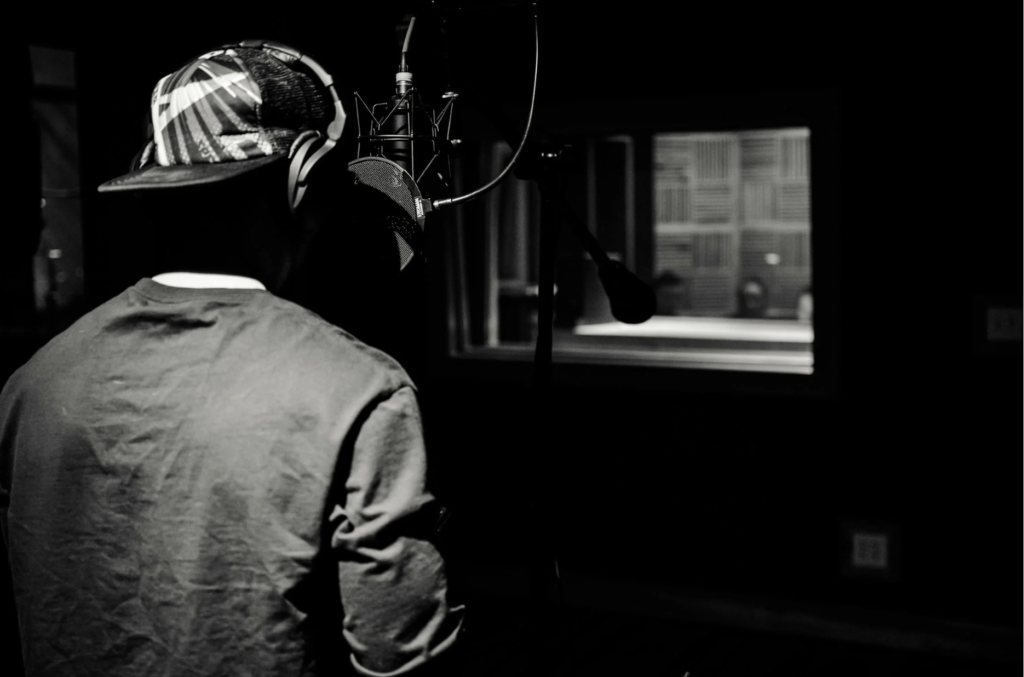Introduction
The image below shows a man in a studio booth, capturing how rap artists record their music. (Man Inside the Recording Studio by Brett Sayles from Pexels.)

The American dream is rooted in the tradition that hard work produces success (Hanson and White 2011). The dream is noted to manifest in various ways because of its individual meanings (Archer 2014; Bukowczyk 2016; Hanson and White 2011), making it supported as an institutionally approved goal (Merton 2002). However, not everyone has the opportunity and access to resources to achieve the goal of the American dream. This is a result of systemic barriers that are ingrained into our institutions (Alexander 2020; Bonnette 2015; Howell and Caisey 2019; Messner, Rosenfeld, and Hövermann 2019; Newman 2016; Omi and Winant 2014) and disadvantage those who are excluded from the normative categories of white, heterosexual, and male. Consequently, people who are impacted by systemic barriers, specifically black men and women, look for alternative routes to achieve wealth and status. These routes, when considering black communities, consist of sports, media, and entertainment (Adeyemo 2022). For some, the music industry, particularly through rap, emerges as a potential pathway (Cloonan and Williamson 2023; Foster 2014; Shapiro 2023). Because rap music serves as a predominately black music genre and echoes the voices of black individuals, it becomes a compelling unit of observation when considering how the American Dream is framed through rap music.
This research revolves around examining the impact of rap artists’ gender on the portrayal of the American Dream within rap lyrics spanning the period from 2001 to 2021.
Gender serves as the independent variable, categorized based on the rapper’s gender identity and their recognition in BET Awards categories such as “Best Female Hip Hop Artist” or “Best Male Hip Hop Artist.” The dependent variable of the research is the rhetoric of the American Dream, characterized by themes of economic success and class mobility. The selection of rap songs from this timeframe provides a representative sample, encompassing early 2000s, 2010s, and early 2020s music. Data for the study were drawn from winners and nominees of the BET Awards for “Best Female Hip-hop Artist” and “Best Male Hip Hop Artist” between 2001 and 2021, totaling 233 nominations, including 110 in the female category and 122 in the male category. Through content analysis and a purposive sampling approach it ensured representation of both genders within the rap genre, while excluding artists who did not primarily identify as rappers. Specific songs were selected based on criteria including:
- 1) the American dream
- (2) the struggles that the rapper had went through to acquire fame/the dream
- (3) symbols associated with wealth and/or struggle.
By systematically analyzing rap lyrics for various themes, this research aims to offer new insights into how gender shapes perceptions and portrayals of the American Dream in hip-hop culture.
Results showed money, lavish lifestyles, and masculinity are all manifestations of the American dream for both Genders. While money was equally expressed among both men and woman, lavish lifestyles were manifested slightly different with the female rappers’ considerations of having men fund their lifestyles. Additionally, masculinity was tied more to male rappers as it was stressed an importance to become an icon and representation. Unlike female rappers who emphasized the desire and need to teach other women about the rap game and not just be an icon. When it came to struggle and persistence, male rappers had a higher presence of struggle and desire for better living with 57% of songs compared to only 38% of female rap songs. Finally, for celebration and success, the ways in which both male and female rappers framed success was similar. However, patterns of self-recognition and fulfillment ere more common among male rappers and confidence in one-self was more common among female rappers. Aligned with celebration, female rappers mentioned more specific credible media outlets that displayed their success in comparison to male rappers.